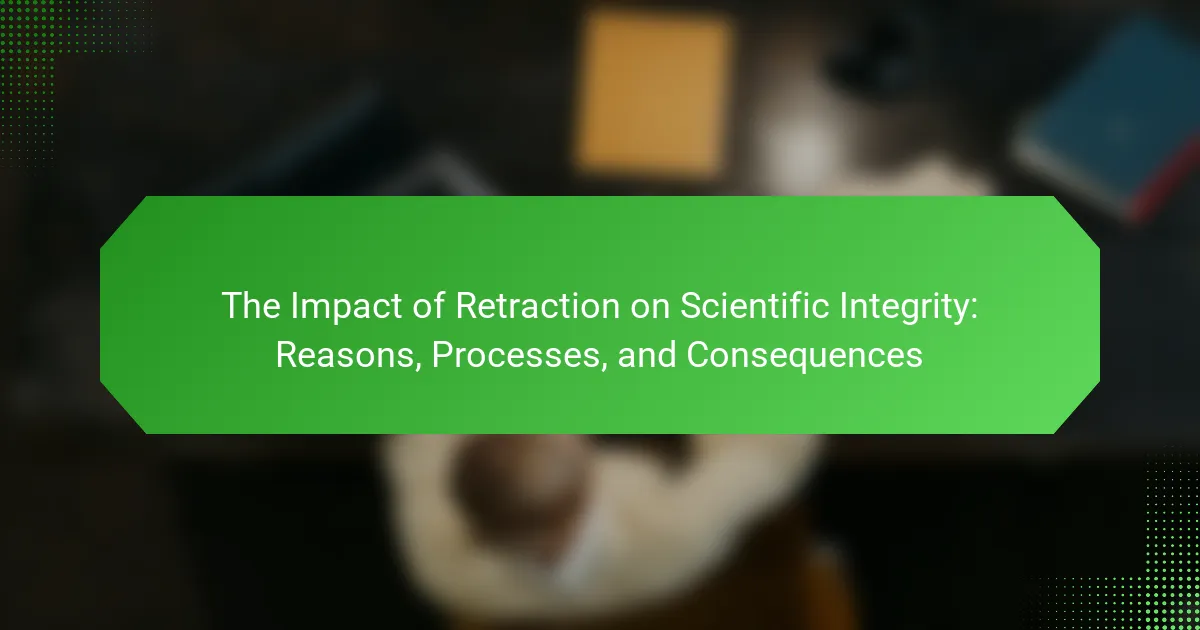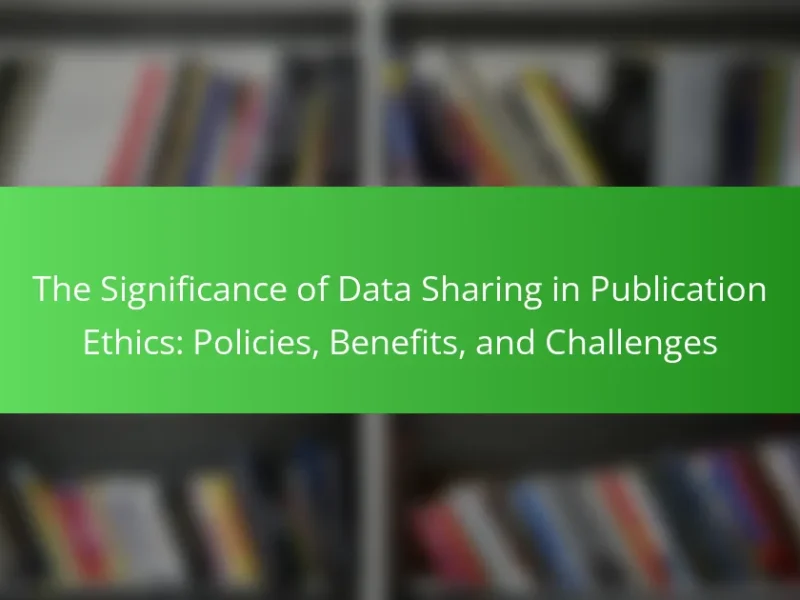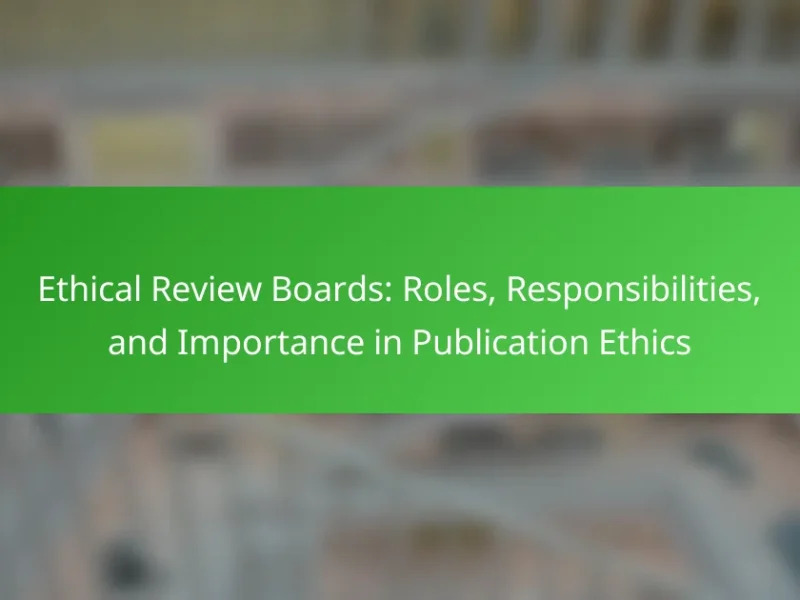Retraction refers to the process of withdrawing published scientific papers due to errors or misconduct, significantly impacting scientific integrity. This article examines the reasons behind retractions, their processes, and the consequences they impose on trust in research. It highlights how retractions can undermine the credibility of scientific literature, lead to skepticism among researchers and the public, and affect the reputation of journals and authors. Additionally, the article discusses the role of rigorous peer review processes and ethical training in minimizing retractions, ultimately promoting accountability and integrity within the scientific community.
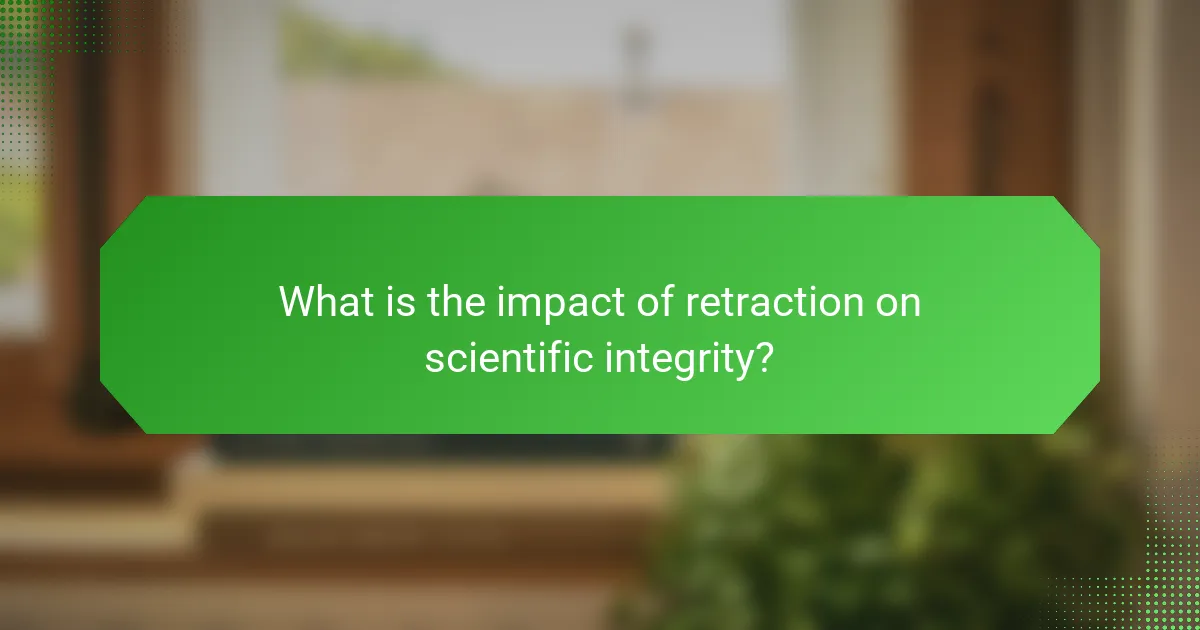
What is the impact of retraction on scientific integrity?
Retraction negatively impacts scientific integrity by undermining trust in published research. It signals that previous findings may be flawed or fraudulent. This can lead to skepticism among researchers and the public. Trust in the scientific community is essential for collaboration and funding. A high rate of retractions can damage the reputation of journals and authors. For example, a study published in 2016 found that retracted papers received significantly fewer citations. This indicates that retraction affects the perceived value of research. Overall, retraction serves as a necessary corrective but poses risks to the credibility of science.
Why are scientific retractions necessary?
Scientific retractions are necessary to maintain the integrity of the scientific record. They correct the literature when research is found to be flawed, fraudulent, or misleading. Retractions help prevent the dissemination of false information that could harm public health or safety. They also uphold the trust in scientific research by ensuring that only credible findings are accepted. According to a study published in the journal “PLOS ONE,” retractions serve as a warning system for researchers and the public about potential inaccuracies. This process fosters accountability among scientists and encourages rigorous peer review. Overall, retractions are essential for preserving the reliability of scientific knowledge.
What circumstances lead to the retraction of scientific papers?
Retraction of scientific papers occurs due to several circumstances. These include instances of misconduct, such as data fabrication or plagiarism. Errors in methodology that compromise the validity of the results also lead to retraction. Additionally, authors may retract papers if they discover significant inaccuracies in their findings post-publication. Conflicts of interest that were not disclosed can also result in retraction. A study by the Retraction Watch database found that approximately 43% of retracted papers were due to misconduct. Overall, these circumstances highlight the importance of integrity in scientific research.
How do retractions affect the credibility of scientific research?
Retractions significantly undermine the credibility of scientific research. They indicate that previous findings may be flawed or unreliable. This can lead to a loss of trust among researchers, funding bodies, and the public. A study published in the journal “Nature” found that retracted articles are often cited less frequently. Furthermore, repeated retractions from the same author can damage their professional reputation. This erosion of credibility can hinder collaboration and funding opportunities. Overall, retractions serve as a critical alert to the scientific community about the integrity of research.
What processes are involved in the retraction of scientific papers?
The retraction of scientific papers involves several key processes. Initially, the author or publisher identifies a significant error or ethical concern. The next step typically includes an investigation to verify the claims. This investigation may involve peer reviewers or institutional committees. If the findings confirm the issues, the author submits a retraction notice to the journal. The journal then publishes this notice, which should include reasons for the retraction. The retraction is also indexed in databases to inform readers. These processes ensure transparency and maintain scientific integrity.
Who initiates the retraction process and what are their roles?
The retraction process is typically initiated by the authors of a paper. Authors may recognize errors, misconduct, or ethical issues in their work. They are responsible for formally requesting the retraction through the journal that published the paper. Journals play a critical role in this process by evaluating the request and ensuring proper procedures are followed. Editors assess the validity of the retraction reasons provided by the authors. If the retraction is deemed necessary, the journal publishes a retraction notice. This notice informs the scientific community about the retraction and the reasons behind it. The entire process is essential for maintaining scientific integrity and transparency.
What steps are taken to formally retract a publication?
To formally retract a publication, the author must submit a retraction notice to the journal. This notice typically includes the reasons for retraction. The journal editor reviews the request and decides whether to proceed. If approved, the journal publishes the retraction notice. This notice is linked to the original article for clarity. The retraction is recorded in databases like PubMed. This process ensures transparency and maintains scientific integrity. According to the Committee on Publication Ethics, retractions are essential for correcting the scientific record.
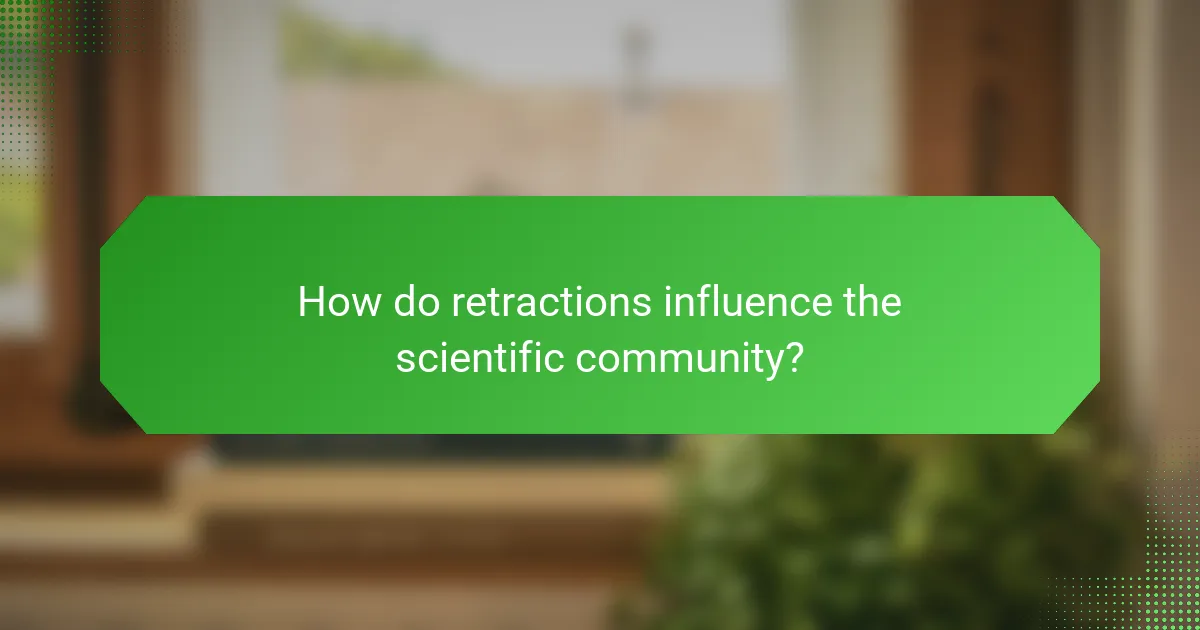
How do retractions influence the scientific community?
Retractions significantly influence the scientific community by promoting accountability and integrity. They serve as a mechanism to correct the scientific record. When a paper is retracted, it alerts researchers to potential errors or misconduct. This process helps maintain trust in scientific literature. A study published in “PLOS ONE” found that retractions can lead to increased scrutiny of research practices. Additionally, retractions can deter future unethical behavior among researchers. They also encourage journals to improve peer review processes. Overall, retractions play a crucial role in upholding the standards of scientific research.
What are the consequences of retractions on researchers?
Retractions negatively impact researchers’ reputations and credibility. They can lead to loss of funding opportunities. Researchers may face difficulties in publishing future work. Collaborations can become strained due to trust issues. The academic community may view retracted work as a sign of incompetence. In severe cases, researchers may face disciplinary actions from institutions. Retractions can also affect career advancement and job prospects. Overall, the consequences significantly hinder researchers’ professional growth and academic standing.
How do retractions impact funding and career opportunities for scientists?
Retractions negatively impact funding and career opportunities for scientists. A retraction can damage a scientist’s reputation. Funding agencies often scrutinize researchers’ publication records. A history of retractions may lead to reduced grant approval rates. Scientists with retractions may find it harder to secure positions in academia. Employers often prioritize candidates with clean publication histories. The perception of integrity is crucial in scientific communities. Studies show that retracted papers can lead to long-lasting career consequences.
What psychological effects do retractions have on authors?
Retractions have significant psychological effects on authors. Authors often experience feelings of shame and embarrassment after a retraction. This can lead to a loss of self-esteem and confidence in their work. Additionally, authors may face anxiety and stress due to the potential damage to their reputation. Research indicates that the fear of retraction can create a reluctance to publish future work. A study by F. B. K. et al. (2020) highlights that authors reported increased stress levels and social isolation following a retraction. The implications of retractions can extend beyond the individual, affecting collaboration opportunities and career advancement.
How do retractions affect public trust in science?
Retractions negatively affect public trust in science. They signal potential flaws in research integrity. A study by Van Noorden in 2017 found that high-profile retractions can lead to skepticism about scientific findings. Public perception may shift, viewing science as less reliable. This skepticism can hinder public engagement with scientific issues. Trust is crucial for effective communication of scientific information. The more retractions occur, the greater the erosion of trust. This trend underscores the importance of maintaining rigorous research standards.
What role does media coverage play in shaping perceptions of retractions?
Media coverage significantly influences public perceptions of retractions. It shapes how the scientific community and the general public understand the implications of a retraction. Positive or neutral coverage can mitigate negative perceptions, while sensationalized reporting can exacerbate distrust in scientific findings. Studies show that media portrayal often emphasizes the scandal aspect, overshadowing the corrective nature of retractions. For example, a study published in the journal “PLOS ONE” found that articles with sensational headlines led to increased public skepticism about the reliability of scientific research. Thus, the role of media is crucial in framing the narrative surrounding retractions and their impact on scientific integrity.
How can transparency in the retraction process restore public confidence?
Transparency in the retraction process can restore public confidence by ensuring accountability and clarity. It allows stakeholders, including researchers and the public, to understand the reasons behind a retraction. Clear communication about errors or misconduct fosters trust in the scientific community. When retractions are handled transparently, it demonstrates a commitment to integrity. This approach reduces misinformation and speculation regarding the validity of research. Studies show that transparent processes lead to higher trust levels among the public. For instance, a survey by Nature found that 70% of respondents preferred clear retraction policies. Overall, transparency in retractions reinforces the credibility of scientific work.

What best practices can minimize the need for retractions?
Implementing rigorous peer review processes minimizes the need for retractions. Ensuring multiple experts evaluate research helps identify flaws before publication. Maintaining transparency in data and methodologies allows for reproducibility. Encouraging open discussions among researchers can highlight potential issues early. Training researchers on ethical standards promotes adherence to integrity. Regular audits of published work can catch errors proactively. Establishing clear guidelines for authors on reporting results reduces ambiguity. Collectively, these practices enhance the reliability of scientific literature and decrease retraction rates.
How can researchers ensure the integrity of their work?
Researchers can ensure the integrity of their work by adhering to ethical guidelines and maintaining transparency. They should conduct thorough literature reviews to avoid duplicating existing research. Proper data management practices are essential for accuracy and reproducibility. Researchers must disclose conflicts of interest and funding sources to maintain credibility. Peer review processes help validate findings before publication. Regular training on ethical research practices reinforces integrity. According to a study published in the journal “Nature,” adherence to these practices significantly reduces instances of misconduct and enhances the reliability of scientific literature.
What steps should researchers take during the research and publication process?
Researchers should follow a systematic approach during the research and publication process. First, they must conduct a thorough literature review to understand existing work. This establishes a foundation for their own research. Next, researchers should formulate a clear hypothesis or research question. This guides their investigation and data collection.
After that, they need to design a robust methodology. A well-defined methodology ensures the reliability of results. Researchers should then collect and analyze data according to this methodology. Accurate data analysis is crucial for drawing valid conclusions.
Once results are obtained, researchers should draft their manuscript. The manuscript must clearly present the research findings, methodology, and significance. Following this, researchers should select an appropriate journal for submission. This choice impacts the visibility and impact of their work.
Finally, researchers should respond to peer review feedback. Addressing reviewers’ comments improves the quality of the publication. Successful navigation of these steps contributes to scientific integrity and the overall credibility of research.
How can peer review processes be improved to reduce errors?
Peer review processes can be improved by implementing more rigorous criteria for reviewer selection. This ensures that reviewers have relevant expertise and experience. Increasing transparency in the review process can also help reduce errors. Open peer review allows for greater scrutiny and accountability. Encouraging collaboration among reviewers can lead to more comprehensive evaluations. Providing clear guidelines for reviewers can minimize subjective assessments. Utilizing technology for plagiarism detection can enhance the quality of submissions. Studies show that structured review forms can improve consistency in evaluations. Implementing these strategies can significantly enhance the reliability of peer review outcomes.
What resources are available for understanding scientific retractions?
Key resources for understanding scientific retractions include databases and journals that track retracted studies. The Retraction Watch Database is a primary resource, cataloging retractions with detailed information. Another valuable resource is the PubMed database, which highlights retracted articles in the biomedical field. The Committee on Publication Ethics (COPE) provides guidelines and best practices regarding retractions. Additionally, academic journals often publish retraction notices that explain the reasons behind each retraction. Research articles analyzing the trends and impacts of retractions also serve as informative resources.
Where can researchers find guidelines on ethical publishing practices?
Researchers can find guidelines on ethical publishing practices through various reputable sources. The Committee on Publication Ethics (COPE) provides comprehensive resources and guidelines for ethical publishing. Additionally, the International Committee of Medical Journal Editors (ICMJE) offers specific recommendations for medical journals. The American Psychological Association (APA) also has ethical guidelines relevant to psychology research publications. These organizations emphasize transparency, integrity, and accountability in the publication process. Many academic journals also include their own ethical guidelines on their websites, which are tailored to their specific fields.
What tools exist to track and analyze retractions in scientific literature?
Retraction Watch and PubPeer are key tools that track and analyze retractions in scientific literature. Retraction Watch provides a comprehensive database of retracted papers and offers insights into the reasons behind these retractions. PubPeer allows researchers to discuss and comment on published studies, highlighting potential issues that may lead to retractions. Additionally, the CrossRef database includes retraction notices linked to original articles, facilitating easy access to retracted content. These tools collectively enhance transparency and accountability in scientific research.
What strategies can researchers adopt to handle retractions effectively?
Researchers can adopt several strategies to handle retractions effectively. First, they should maintain transparent communication with their institutions and stakeholders. This fosters trust and clarity during the retraction process. Second, researchers must thoroughly understand the reasons for the retraction. This knowledge allows them to address any underlying issues in future work. Third, they should document the retraction process and its outcomes. This can serve as a learning tool for themselves and others in the field. Fourth, researchers should engage with the academic community to discuss the implications of the retraction. This can lead to collaborative solutions and improvements in research integrity. Lastly, they should focus on ethical research practices to minimize the risk of future retractions. A study by Fang et al. (2012) published in PLOS ONE highlights that retractions often stem from misconduct or errors, emphasizing the importance of ethical diligence.
The main entity of this article is scientific retraction, which significantly impacts scientific integrity. The article examines the negative effects of retraction on trust in research, the necessity of retractions for maintaining the scientific record, and the circumstances leading to retraction. It details the processes involved in retracting papers, the consequences for researchers, and how retractions influence public trust in science. Additionally, best practices for minimizing retractions and resources for understanding ethical publishing are discussed, emphasizing the importance of transparency and accountability in scientific research.
